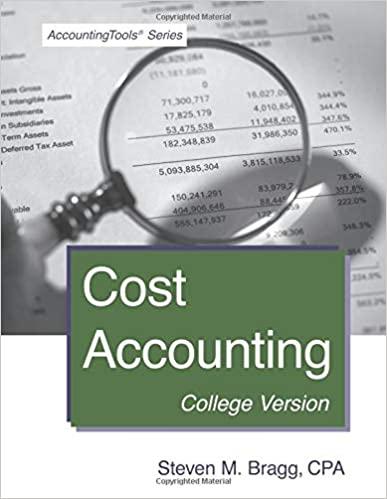Hi-Tek Manufacturing, Inc., makes two types of industrial component parts--the B300 and the T500. An absorption costing income statement for the most recent period is shown: Hi-Tek Manufacturing Inc. Income Statement Sales $ 1.6 33.300 Cost of 1,2 20,9 2 2 goods sold Gross margin 4 1 2, 3 7 8 Selling and administrative 650,000 expenses Net operating $ (2 3 7,6 2 2). loss es Hi-Tek produced and sold 60,100 units of B300 at a price of $19 per unit and 12,600 units of T500 at a price of $39 per unit. The company's traditional cost system allocates manufacturing overhead to products using a plantwide overhead rate and direct labor dollars as the allocation base. Additional information relating to the company's two product lines is shown below: Total $ T5 0 0 $ 1 6 2.4 0 0 $ 4 2,700 3 0 0 Direct $ 4 0 0,6 0 0 materials Direct labor $1 2 0.6 0 0 Manufacturing overhead Cost of goods sold 5 6 3 0 0 0 16 3. 3 0 0 4 9 4 6 2 2 $1,2 20,9 2 2 The company has created an activity-based costing system to evaluate the profitability of its products. Hi-Tek's ABC implementation team concluded that $58,000 and $100,000 of the company's advertising expenses could be directly traced to B300 and T500, respectively. The remainder of the selling and administrative expenses was organization- sustaining in nature. The ABC team also distributed the company's manufacturing overhead to four activities as shown below: Activity Manufacturing Overhead B 3 0 0 T5 0 0 Total $ 204,0 8 2 90 , 2006 2,1 0 0 1 5 2, 3 0 0 1 2 8,0 4 0 7 1 Activity Cost Pool (and Activity Measure) Machining (machine- hours) Setups (setup hours) Product- sustaining (number of products) Other (organization- sustaining costs Total 2 2 0 29 1 101,600 1 1 2 6 0.9 00 NA NA NA manufacturing $ 4 9 4,6 2 2 overhead cost Required: 1. Compute the product margins for the B300 and T500 under the company's traditiona costing system. 2. Compute the product margins for B300 and T500 under the activity-based costing system. 3. Prepare a quantitative comparison of the traditional and activity-based cost assignments. Complete this question by entering your answers in the tabs below. Required Required Required 1 2. 3 Compute the product margins for the B300 and T500 under the company's traditional costing system. (Round your intermediate calculations to 2 decimal places and final answers to the nearest whole dollar amount.) Show less B300 T500 Total Product margin Required: 1. Compute the product margins for the B300 and T500 under the company's traditional costing system. 2. Compute the product margins for B300 and T500 under the activity-based costing system 3. Prepare a quantitative comparison of the traditional and activity-based cost assignments. Complete this question by entering your answers in the tabs below. 3 Required Required Required 1 Compute the product margins for B300 and T500 under the activity-based costing system. (Negative product margins should be indicated by a minus sign. Round your Intermediate calculations to 2 decimal places.) Show less B300 T500 Total Product margin Required Required Required 1 3 Prepare a quantitative comparison of the traditional and activity-based cost assignments. (Round your Intermediate calculations to 2 decimal places and "Percentage" answers to 1 decimal place and and other answers to the nearest whole dollar amounts.) Show less B300 T500 Total % of % of Amount Amount Amount Traditional Cost System %ol 944 % 94 + % Total cost assigned to products Total cost Total B300 96 of Total Amount Amount T500 % of Total Amount Amount Amount Activity-Based Costing System Direct costs % Indirect costs Total cost Total B300 96 of Total Amount Amount T500 % of Total Amount Amount Amount Activity-Based Costing System Direct costs % % % *** Indirect costs: % % % 9 % 9 Total cost assigned to products Costs not assigned to products: Total cost













